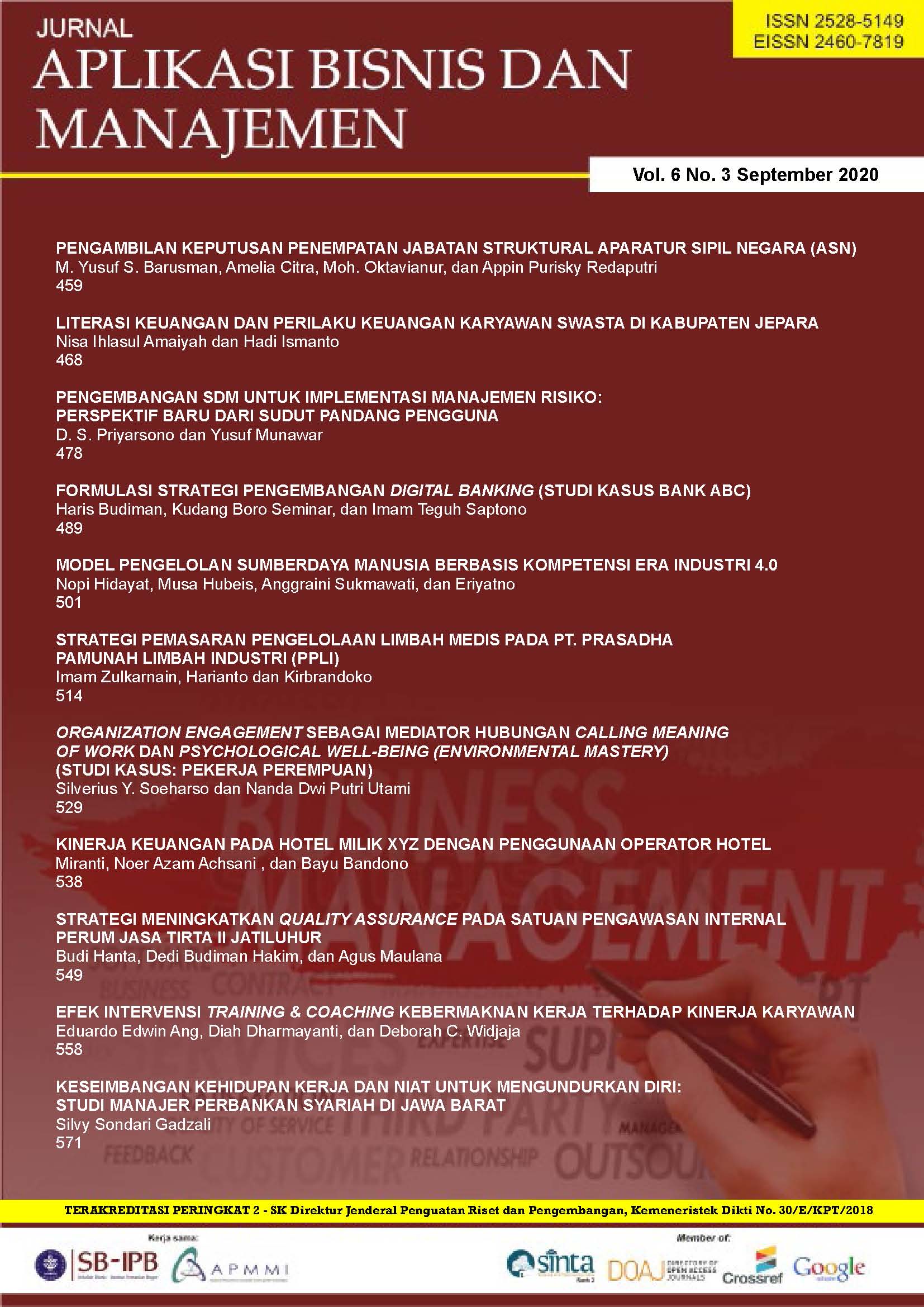MODEL PENGELOLAAN SUMBERDAYA MANUSIA BERBASIS KOMPETENSI ERA INDUSTRI 4.0
COMPETENCY-BASED HUMAN RESOURCE MANAGEMENT MODEL IN THE INDUSTRIAL ERA 4.0
Abstract
The symptoms caused by the existence of industry 4.0 indirectly encourage or force the organization to prioritize human resource management (Human Resource Management) so that it can last a long time and develop more advanced. This research was conducted to build a design model of competency-based human resource management across generations of the industrial era 4.0 using a soft system method. Generational differences that have been considered problems, are seen differently when the differences in the characteristics of the three generations (baby boomers, X and Y) are used as opportunities and complementary strengths in the challenges of the industrial world 4.0. In the current competency-based human resource management there are some gaps. The competency-based human resource management model across generations of 4.0 provides strategic steps taken in managing human resources.
Keywords: generation, human resource management model, industry 4.0, soft sytem method
Downloads
References
Ashkezari MJD, Aeen MN. 2012. Using Competency Models to Improve HRM. Conference Prosiding
Asroh MFM, Abdulla CZ. 2017. Motivational Driven and Learning Culture for Organization Performance. International Journal of Academic Research in Business and Social Sciences. 7(2) : 523-530
Bala A. 2017. Role of public administration in good governance and local development. International journal of economics, commerce and management. 5(5) : 593-601
Crestone C. 2014. HR technologies, service delivery approaches, and metrics. Geogia (GE) : Crestone Cedar.
Daswati. 2012. Implementasi peran kepemimpinan dengan gaya kepemimpinan menuju kesuksesan organisasi. Jurnal academica. 4(1) : 783-798
Eriyatno. (2012). Ilmu Sistem: Meningkatkan Mutu dan Efektivitas Manajemen. Jilid Satu, Edisi keempat. Larasati L, editor. Surabaya (ID): Penerbit Guna Widya
Hubeis M, Najib M. 2014. Manajemen Strategik Dalam Pengembangan Daya Saing Organisasi. Jakarta (ID): Kompas Gramedia.
Hussein N, Omar S, Noordin F, Ishak NA. 2016. Learning organization culture, organizational performance and organizational innovativeness in a public institution of higher education in malaysia: a preliminary study. Procedia economics and finance. 37(1) : 512 – 519
Ignasius J, Hashemian SMH, Behzadian M, Samizadeh R. 2014. A fuzzy hybrid group decision support system approach for the supplier evaluation process. The international journal of advanced manufacturing technology. 73(1) : 1105-1117.
Kavanagh M J, Thite M, Johnson RD. 2015. Human resource information systems. Thousand Oaks (CA) : Sage.
Kraus M. 2016. Comparing generation x and generation y on their preferred emotional leadership style. Journal of applied leadership and management. 5(1) : 62-75
Mackey A. 2008. The effect of CEOS on firm performance. Strategic management journal. 29(12) : 1357-1367
Nicholson GJ, Newton CJ. 2010. The role of the board of directors : perceptions of managerial elites. Journal of management and organization. 16(2):201-218.
Ozcelik G. Ferman M. 2006. Competency approach to human resources management: outcomes and contribution in a turkish cultural context. Human resource development review. 5(1) : 72-91
Pramudyo A. 2013. Implementasi manajemen kepemimpinan dalam pencapaian tujuan organisasi. Jurnal bisnis, manajemen, dan akuntansi.1(2): 49-61
Qiao JX,Wang W.2009. Managerial competencies for middle managers: some empirical findings from China. Journal of european industrial training. 33(1): 69-80.
Rhodes RAW. Governance and Public Administration. Journal of public administration. 57(1) : 1-56
Rosser R. 1994. Issues of measurement in the design of health indicators: a review health indicator. New York (US) : St Martins Press.
Saaty TL. 1994. Fundamental of Decision Making and Priority Theory with The Analytic Hierarchy Process. University of Pittsburgh (US) : RWS publication
Saaty TL.2010. Analytical hierarchy process. Prosiding jurnal. 6(1) : 478-488
Saputri SW. 2018. Pemilihan software antivirus untuk laboratorium komputer akuntansi dengan metode ahp (analytical hierarchy process). Jurnal akuransi. 5(2) : 11-21
Seyyedjavadin RS, Zadeh HM. 2009. HR Staretgy and Its Aligning with Organizational Strategy and Human Capabilities. IJMS 2(2) :5-29
Shahzad F,Luqman RA, Khan AR, Shabbir L. 2012. Impact of organizational culture on organizational performance: an overview. Interdisciplinary journal of contemporary research in business.3(9): 975-985
Stone DL, Deadrick DL, Lukaszewski KM, Johnson R J. 2015. The influence of technology on the future of human resource management. Human Resource Management Review. 25(2): 216–231
Widyaningsih EY. 2012. Penerapan analisis hirarki proses ( ahp ): dalam penentuan formula alokasi dana desa di Kabupaten Sragen [Tesis]. Surakarta (ID) : Universitas Negeri Surakarta
Woszcyna KS. 2014. The importance of organizational culture for innovation in the company. Forum scientiae oeconomia. 2(3) : 27-39
Wright, Patrick M. 2008. Human








